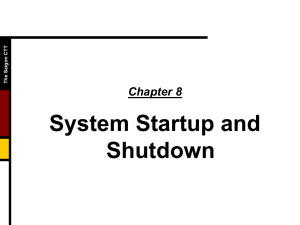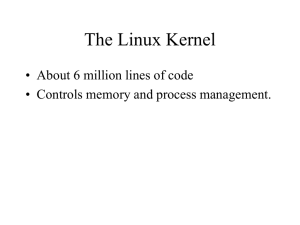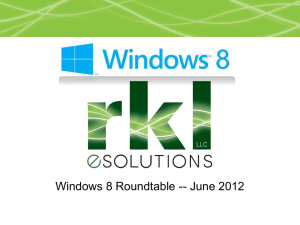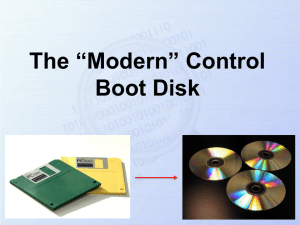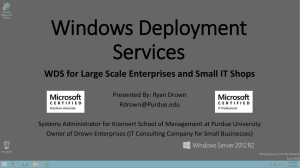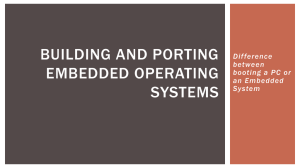boot-1
advertisement
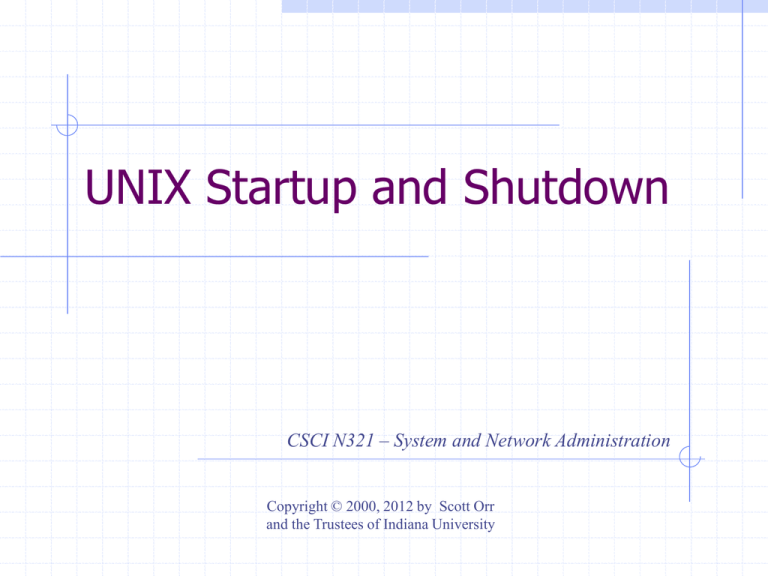
UNIX Startup and Shutdown CSCI N321 – System and Network Administration Copyright © 2000, 2012 by Scott Orr and the Trustees of Indiana University Section Overview Bootstrapping Startup Scripts and Run Levels Boot Configuration and Troubleshooting System Shutdown References CQU COIT13146 System Administration Course Chapter 13 Monolithic Kernels Application User Mode VFS IPC, File System Scheduler, Virtual Memory Kernel Mode Device Drivers, Dispatcher, … Hardware Source:http://en.wikipedia.org/wiki/Monolithic_kernel Microkernels Application Application IPC UNIX Server Device Drivers File Server Basic IPC, Virtual Memory, Scheduling User Mode Kernel Mode Hardware Source:http://en.wikipedia.org/wiki/Microkernel Bootstrapping Starting the system Process of loading kernel into memory Boot Modes Normal Single User/Safe Mode Rescue (on DVD) RedHat Boot Process BIOS GRUB /etc/rc.d/ rc3.d /etc/inittab Linux Kernel init /etc/rc.d/ rc.sysinit /etc/rc.d/rc Login Shell RL Specific /etc/inittab /etc/rc.d/ rc5.d Source: http://nmc.nchu.edu.tw/linux/Linux_boot.htm Fedora Boot Process BIOS GRUB /etc/rc.d/ rc3.d systemd Linux Kernel Systemd init Login Shell /etc/ init/*.conf RL Specific /etc/rc.d/ rc5.d Source: http://nmc.nchu.edu.tw/linux/Linux_boot.htm Boot Process Power On Self Tests (POST) Run Boot Loader(s) Load & initialize kernel Detect & configure devices Fork system processes (Stop if Single User mode) Run startup scripts Start multiuser operations Boot Loader ROM loads Master Boot program from disk Primary Bootloader BIOS - Basic I/O, Program Loading UEFI – Unified Extensible Firmware Interface 2nd Boot Loader finds/loads kernel Checks available memory Initializes kernel internal data structures NTLDR – Microsoft Boot Loader GRand Unified Bootloader (GRUB/GRUB2) Can boot multiple OS Boot options can be edited at boot GRUB Images (/boot/grub2) boot.img – Loaded first on BIOS systems diskboot.img – first sector of core image cdboot.img – DVD version of diskboot.img core.img Main image Includes kernel.img and module lists Built with grub-mkimage kernel.img – Basic run-time functions *.mod – Dynamically loadable modules Basic grub.cfg options Shell script in /etc/boot2 set default=“0” set timeout=“5” menuentry ‘Fedora’ <options> set root=‘(hd0,gpt2)’ linux /vmlinuz-<version> <options> initrd /initranfs-<version> Creating grub.cfg Compiled using grub2-mkconfig /etc/default/grub Variables to change default settings /etc/grub.d/* 00_header 10_linux 40_custom System Processes BSD Systems swapper – PID 0 init – PID 1 pagedaemon – PID 2 AT&T SVR4 sched – PID 0 (invisible under RedHat) init – PID 1 /etc/inittab Startup Services Hostname Timezone Check the hard drives Mount the hard drives Remove files from /tmp Configure network interfaces Start daemons and network services BSD /etc/rc* Scripts /etc/rc Master script Executes supplemental scripts Example supplemental scripts (freeBSD) /etc/defaults/rc.conf /etc/rc.conf /etc/rc.conf.local /etc/inittab Initializes system for use Format: id:rl:action:process id: uniquely identifies entry rl: Run level entry applies to action: How to execute process process: process command line Ex: Setting the default Runlevel: id:3:initdefault Replaced in Fedora with systemd Systemd Becoming more prevalent in Linux Distros Currently used by Fedora and OpenSUSE Testing in Debian Mostly compatible with the init system init scripts are read as alternative format Established functionality such as fstab still supported Systemd - Units Uses a dependency system between “units” Requires/Wants Conflicts Before After Encapsulate objects relevant to booting and maintenance Configured in config files May be tied through symbolic links Systemd – Unit Types Different unit types control different aspects of the operating system service: handles daemons socket: handles network sockets target: Logical grouping of units (example: runlevel) device: expose kernel devices mount: controls mount points of the files system automount: mounts the file system snapshot: references other units (similar to targets) Systemd Unit File Section [Unit] Description Requires Wants Conflicts Before After Systemd Service Section [Service] Type= simple|oneshot|forking|dbus|notify|idle ExecStart ExecReload ExecStop Restart= no|on-success|on-failure|on-abort|always Systemd Install Section [Install] Wantedby= Used to determine when to start (e.g. Runlevel) Startup Run Levels RedHat 1 (S) 2 3 4 5 6 0 Mode Single user Multiuser (no networking) Full Multiuser Unused X11 Reboot Halt Systemd – Runlevels Runlevel is defined through a symbolic to one of the runlevel targets Runlevel Target Runlevel 3: /lib/systemd/system/multi-user.target Runlevel 5: /lib/systemd/system/graphical.target Change Runlevel: Remove current link /etc/systemd/system/default.target Add a new link to the desired runlevel Systemd - Virtual Consoles Started in /etc/systemd/system/getty.target \ .wants/getty@tty#.service /sbin/agetty agetty <port> <baud rate> Alternative Linux getty Opens tty port and prompts for login Systemd - Virtual Consoles Example: getty@tty1.service [Unit] Description=Getty on %I BindTo=dev-%i.device … [Service] Environment=TERM=linux ExecStart=-/sbin/agetty %I 38400 Restart=always RestartSec=0 UtmpIdentifier=%I KillMode=process … /etc/init/*.conf directives exec script start on <event> stop on <event> task respawn See man 5 init for more “Events” control-alt-delete power-status-changed startup runlevel <runlevel> started <job> stopped <job> /etc/init - Virtual Consoles Started in /etc/init/start-ttys.conf tty restarts in /etc/init/tty.conf Example: /etc/init.d/tty.conf: # tty - getty # # This service maintains a getty on the sepcified device. stop on runlevel [016] respawn instance $TTY exec /sbin/mingetty $TTY /etc/init - Run Levels Started in /etc/init/rc[S].conf: Example (rc.conf): start on runlevel [0123456] stop on runlevel [!$RUNLEVEL] task export RUNLEVEL console output exec /etc/rc.d/rc $RUNLEVEL Run Level Scripts Actual scripts - /etc/rc.d/init.d/ /etc/rc.d/rc#.d/ Symbolic links to /etc/init.d scripts S## - Start scripts K## - Stop scripts /etc/sysconfig/ - script configuration files chkconfig <script> on|off service <script> start|stop|restart Startup Messages Displayed to console RedHat – daemon [ ok ] /bin/dmesg History of boot messages Convenient to search RedHat allows for interactive setup (“i”) Windows Boot Options <F8> When system starts booting… Boot Display During Safe Mode System Shutdown Turn off power – BAD!!! Reboot reboot shutdown –r Halting the system halt shutdown –h Changing the Run Level telinit <mode> shutdown –i<mode> When to Shutdown Failures Maintenance and Upgrades Regularly Scheduled Housecleaning Window for Maintenance/Upgrades User Notification /etc/motd Email Support web pages




